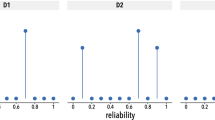Abstract
Admissible probability measurement procedures utilize scoring systems with a very special property that guarantees that any student, at whatever level of knowledge or skill, can maximize his expected score if and only if he honestly reflects his degree-of-belief probabilities. Section 1 introduces the notion of a scoring system with the reproducing property and derives the necessary and sufficient condition for the case of a test item with just two possible answers. A method is given for generating a virtually inexhaustible number of scoring systems, both symmetric and asymmetric, with the reproducing property. A negative result concerning the existence of a certain subclass of reproducing scoring systems for the case of more than two possible answers is obtained. Whereas Section 1 is concerned with those instances in which the possible answers to a query are stated in the test itself, Section 2 is concerned with those instances in which the student himself must provide the possible answer(s). In this case, it is shown that a certain minor modification of a scoring system with the reproducing property yields the desired admissible probability measurement procedure.
Similar content being viewed by others
References
de Finetti, B. La prévision: ses lois logiques, ses sources subjectives.Annales de l'Institut Henri Poincaré, 1937,7. [Translated and reprinted as “Foresight: its logical laws, its subjective sources” in H. E. Kyburg, Jr. and H. E. Smokler (Eds.)Studies in subjective probabilities. New York: Wiley, 1964]
de Finetti, B. Does it make sense to speak of good probability appraisers? In I. J. Good (Gen. Ed.)The scientist speculates. New York: Basic Books, 1962. Pp. 357–364.
Massengill, H. E. and Shuford, E. H., Jr. Direct vs. indirect assessment of simple knowledge structures. ESD-TR-65-542, Decision Sciences Laboratory, L. G. Hanscom Field, Bedford, Mass., 1965.
Ramsey, F. P.The foundation of mathematics and other logical essays. New York: Humanities Press, 1926. [The relevant essay, “Truth and probability,” is also reprinted in H. E. Kyburg, Jr. and H. E. Smokler (Eds.)Studies in subjective probabilities. New York: Wiley, 1964]
Roby, T. B. Belief states: a preliminary empirical study. ESD-TDR-64-238, Decision Sciences Laboratory, L. G. Hascom Field, Bedford, Mass., 1965.
Savage, L. J.The foundations of statistics. New York: Wiley, 1954.
Shuford, E. H., Jr. Cybernetic testing. ESD-TR-65-467, Decision Sciences Laboratory, L. G. Hanscom Field, Bedford, Mass., 1965.
Shuford, E. H., Jr. and Massengill, H. E. On communication and control in the educational process. ESD-TR-65-568, Decision Sciences Laboratory, L. G. Hanscom Field, Bedford, Mass., 1965.
Toda, M. Measurement of subjective probability distributions. ESD-TDR-63-407, Decision Sciences Laboratory, L. G. Hanscom Field, Bedford, Mass., 1963.
van Naerssen, R. F. A scale for the measurement of subjective probability.Acta Psychologica, 1961, 159–166.
Author information
Authors and Affiliations
Additional information
The research reported in this paper was, in part, performed at the Decision Sciences Laboratory in support of Project 4690, Information Processing in Command and Control and, in part, sponsored by the Air Force Systems Command Electronic Systems Division, Decision Sciences Laboratory, under Contract No. AF 19(628)-4304, with ARCON Inc. This report is identified as ESD-TR-65-567. Further reproduction is authorized to satisfy the needs of the U. S. Government.
Rights and permissions
About this article
Cite this article
Shuford, E.H., Albert, A. & Edward Massengill, H. Admissible probability measurement procedures. Psychometrika 31, 125–145 (1966). https://doi.org/10.1007/BF02289503
Received:
Revised:
Issue Date:
DOI: https://doi.org/10.1007/BF02289503




